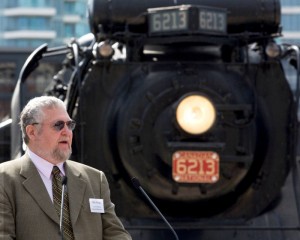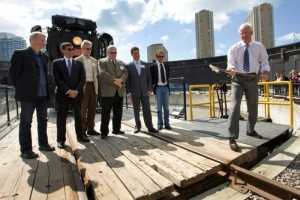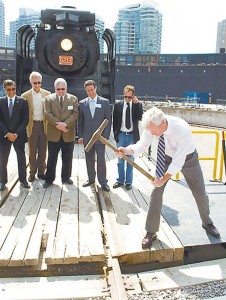Iconic Downtown Railway Heritage Site Welcomes Leon’s!



Click on each picture for a closer look!
.
The pictures at the left and in the middle above are two more images by Norm Betts, the professional photographer who has been chronicling the development of Roundhouse Park through photographic images. They are from the July opening of the Leon’s new store. At that time, another Norm – Norm Nelson – captured the event in the following article about the opening as well as the development of the Toronto Railway Heritage Centre. With the permission of “Inside Toronto“, a great website which provides community news online to the citizens of Toronto, we reprint the article here and the headline photo for the article by Dan Pearce (above right) which shows Mayor David Miller driving in the last spike for the $25-million Roundhouse revitalization project Wednesday on July 8th, 2009 :
.
Iconic downtown railway heritage site welcomes Leon’s
.
By NORM NELSON
July 21, 2009 12:36 PM
www.insidetoronto.com
.
A 40,000-square-foot furniture super store has now joined a local upscale brewery as the sole two commercial tenants of one of the most revered railroad heritage sites in Canada. The new Leon’s Furniture outlet, which officially opened in July, along with already opened Steam Whistle Brewery take up most of the space at the so-called John Street Roundhouse, nestled in the shadow of the CN Tower, just south the Rogers Centre. The cavernous half-round structure sits in Roundhouse Park, a currently fenced-off city park that is expected to re-open later this summer with a railway heritage theme. The site is also known as the Toronto Railway Heritage Centre.
.
“I have to say I was one of those who paused when I was told that a leading furniture retailer would be the major tenant,” Mayor David Miller said at last week’s official opening ceremony. “But my staff said to me, ‘Wait till you see what they’re going to do – it’s going to be extraordinary. And they were right.” Mayor Miller went on to term it “the most extraordinary, adaptive reuse of a heritage building, probably in Canada.”
.
Of course, Mayor Miller wasn’t about to leave out the building’s other major tenant. “I do want to thank and acknowledge and thank our first partner, Steam Whistle Brewing – I’ve spent many happy hours over there,” he quipped.
.
Adam Vaughan, whose downtown ward (Trinity-Spadina) encompasses Roundhouse Park, also related a similar conversion as the mayor. “I was one of those that was probably the most outspoken critic, most worried about what would happen when Leon’s opened. I can tell you that walking into the store today is matched only by my (first) meeting with Terry Leon when he sat down and explained what the family wanted to do here…and it took me five minutes to be won over. This is an extraordinary commitment to the city, an extraordinary commitment to the culture of the city…it’s a real gift to my ward and a real gift to the city.” He said the project “is one of the finest examples of the three R’s. It’s reusing a beautiful old building. It’s reducing what would happen if you demolished heritage architecture and simply sent it off to a landfill. Instead you capture the embedded energy and you put it to better use housing a new and revitalized vision for the downtown of this city, and also it recycles the notion of the rail history of this city.”
.
Orin Krivel, president of the Toronto Railway Historical Association (TRHA), called it a “significant event in the preservation of Toronto’s railway heritage.” The TRHA is the charitable, volunteer group who, hand in hand with the city, is tirelessly working to bring Roundhouse Park literally on track. “With the opening of the Leon’s store, the magnificent 1929 Canadian Pacific Railway John Street Roundhouse is fully occupied, and, thus ensures the economic viability of the Toronto Railway Heritage Centre,” said Krivel.
.
One of the unique aspects of the partnership was the pre-paying of 60 years of rent. “That generated much needed capital to build the museum and do other railway-themed park improvements that you see around us,” explained Glen Garwood, project director from the city’s culture division.
.
One key attribute the redevelopment had going for it, explained Barry Zagdanski, president of State Building Group, which serves as the head landlord, was a well-worn real estate cliche – “location, location, location.” “Just look around,” he told those assembled at the ceremony. “The CN Tower, the Rogers Centre, the Air Canada Centre, thousands of condominiums built and going to be built. The Roundhouse is just a short walk away, via the Skywalk, from the public transit at Union Station and it’s well served by major highways and main roads. “It has the added benefit of having an easily accessed underground parking lot with a pedestrian exit right at our door.” As the landlord, he said they were looking for some very specific types of tenants for the Roundhouse.
.
First of all, they wanted to ensure continuing public access, which excluded industrial uses. And they also wanted the historic structure to be visible from within which excluded its use as office or small retail space. Retrofitting the building in such a manner, he explained, “would have ruined the heritage character. “The beauty and the impact of the space, which comes from its high ceilings, massive windows and doors would have been destroyed.”
.
One thing both Leon’s and Steam Whistle shared, despite being 10 years apart in their move-in dates, was the same heritage architect, Don Louks. “He literally knew every brick and beam in the roundhouse,” said Garwood. Louks said the project represents “something that is very unusual in heritage conservation and heritage preservation…a balance of new and old. If nothing else, when you walk through this building and you walk through this site, you’ll see how a building of this quality can be adapted to be used for a number of things.”
Terry Leon, the grandson of Leon’s founder Ablan Leon, said the Canadian company, which is celebrating its 100th anniversary this year, knew at the outset that “in order to make it a success, we had to be both flexible and innovative. Our objective is no doubt to be successful in our own business but more importantly to do honour to the spirit of the Roundhouse and the citizens of this great city. We believe that if you do the latter, the former will follow.”
.
But, while you can buy furnishings for your home from Leon’s and beer for your fridge from Steam Whistle, the heritage centre is not quite yet ready for public perusal although work “is well underway,” said Krivel, in an interview after the Leon’s ceremony. First to come online should be Roundhouse Park which should be “visitable probably late September, early October. But, it will be fully functioning next year.” Two sets of track are already laid, one to shuffle the site’s historical trains around and the other smaller gauge track for the miniature authentic mini steam train, which will eventually provide rides for visitors.
.
The Roundhouse is a 32-bay semicircular structure, like a half moon, with all parts of the structure equidistant from the historically significant, 120-foot turntable which is again fully operational. In fact, it was used to dramatic effect at the opening as the turntable slowly spun the train to face the assembled onlookers at the official opening. Members of the head table, including Mayor David Miller, then took turns ceremoniously hammering in the last spike to officially reopen the turntable.
.
Making the turntable operational was among the first orders of business so the trains still inside the roundhouse could be removed, via the turntable, to make way for the extensive interior renovations. It’s these locomotives that are now stored in the park, most of them still covered up in weather-proof plastic.
.
In its heyday, the turntable, which looks just like a gigantic turntable but one large enough to carry a locomotive, was used extensively, delivering locomotives to the various bays for servicing. The tracks into the bays are still in place, but of course the only bays the locomotives will now go into are the three retained by the TRHA (bays 15, 16 and 17). Steam Whistle and Leon’s Furniture take up, respectively, bays 1 to 14 and bays 18 to 32.
.
So meticulous has been the reconstruction that underneath the floor, the original Roundhouse floor – train tracks and all – is still preserved, and could easily be restored, if needed. One key compromise that has been made in the name of progress is a thoroughly modern green footprint. Head architect Louks said “not only is the heating of the building by district heat (a central system which distributes heat to numerous Toronto buildings), the cooling of the building uses deep water cooling (a similar downtown distribution system to the district heat). So we not only saved the building, we made it sustainable.”
.
There is a reason the Toronto Railway Heritage Centre is not called a museum. The heritage centre, which is at the so-called Roundhouse Park, just south of the CN Tower, “has many components,” Orin Krivel, president of the Toronto Railway Historical Association (TRHA), explained. The TRHA was formed in 2001, he explained, “by a group of dedicated volunteers determined not to let our rail heritage fade into obscurity. It does get a tad confusing, but the TRHA, which is now a federally registered charity, is the volunteer, charitable group, which is restoring the heritage centre in partnership with the City of Toronto.
.
We prefer using ‘heritage centre’, rather than ‘museum’, as we have separate locations for various components rather than one location labelled museum.” Bays 15 to 17 of the 32-bay cavernous Roundhouse building, which also houses Leon’s Furniture and Steam Whistle Brewery, he said, “are being restored to their original use as they existed in 1929 – that of repair and servicing of locomotives. Public viewing of the work will be part of the visitor’s experience.” Roundhouse Park, he added, is being restored “with a rail ambience. He noted that:
- “We have installed one mile of standard gauge rail linked to our restored and fully operational 120-foot turntable;
- We have assembled a village of Toronto rail treasures to the east end of the park – The Don Station, the Cabin D interlocking tower, a watchman’s shanty, and a tool shed, all to be restored not only in appearance, but in functionality;
- A live steam miniature railway will allow visitors to tour the site in a working steam powered train;
- The machine shop, along the western end of the roundhouse, will be redeveloped into a museum-like display area and will house lecture facilities and accommodations for school tours;
- A computer simulator will be built into the cab of an F-7 diesel locomotive allowing visitors to drive the diesel throughout the Toronto rail lands as they existed in 1952, utilizing the actual controls in the diesel cab. This will be in the machine shop area.”
The Heritage Centre, he said, “will also have a presence in the revitalized Union Station, as we have been interpreting the building for the public by means of comprehensive tours on a monthly basis. Our total museum functions, including our exhaustive historical, sociological and technical libraries and rail materials will be available to one and all via the Internet. From the outset, one of our core self-defined mandates has been education. If Union Station and Roundhouse Park, connected by the Skywalk, are the bookends, then everything in between will also be focused upon. The entire Toronto rail lands, from Bathurst Street to Cherry Street, will be organized into a series of tours. either guided, or self-conducted via downloadable pod casts.”
.
Article by Norm Nelson; Pictures by Norm Betts and Dan Pearce

